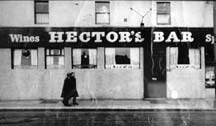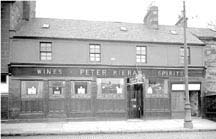1674 Maryhill Road, Glasgow.

This photograph was taken in the 1960s.
There has been a pub on this site since the early 1800s. This part of Maryhill Road was called Main Street, the pubs address was at no 114.
In 1887 John D Hunter took over the business formerly owned by Mr Bowes. Mr Hunter was born in Maryhill not far from the old pub, he received his education in the Mechanics Institution, Glasgow under the able tutelage of Mr Adams. He showed such aptitude and diligence in his studies that a more than usually firm friendship sprung up between master and pupil, so much so that when Mr Adams left the Institution to open up his own in Hampton Court Terrace, Renfrew Street, young Hunter followed him and remained under his guidance for a further three years.
His first job was not that he was trained for, but moved to the drapery trade as cash boy with the well known firm of Messrs Arnott & Company, warehousemen, Jamaica Street. He received a thorough training and knowledge of the trade for five years before being a fully trained draper. Young Hunter met with an accidental injury at work and had to leave the Jamaica Street firm, however he made a full recovery.
Mrs Brown, an aunt, carried on a licensed business in Maryhill at the time, John found himself assisting her in the running of the business for four years. Anxious to strike out on his own, the premises at 114 Maryhill Road came on the market formerly owned by spirit merchant Mr Bowes.
John Hunter was one of the originators of the Maryhill Football Club and was president since its inception. He displayed all the clubs trophies and cups in his public house, on one side of the gantry the massive Scottish Junior Challenge Cup won by the team in 1900, on the other side was the Glasgow Evening News Charity Cup and the Maryhill Charity Cup.
Mr Hunter loved all kinds of outdoor sports, he was a keen bowler and president of the Maryhill Club, he played a good round of golf with the North Western Golf Club and was a cyclist with the Hampton Cycling Club. He was one of sixteen men who inaugurated the Mounted Infantry of the 1st Dumbartonshire Rifle Volunteers, with which corps he remained for four years. In that time he would be drilling at the Barracks for two months, three mornings a week at a quarter to seven.
He inherited a fondness for animals, his late father was a well known and respected carting contractor in Port Dundas. He was a capital horseman and a good judge of horses. He was also a curler and played with the Kelvindock Club winning many prizes.
In 1889 Mr Hunter married Miss Lennie, eldest daughter of William Lennie, licensed grocer, Maryhill, who’s business was carried on for three generations in Maryhill.

Peter Kieran’s Bar.
Peter Kieran took over the pub in 1911 paying an annul rent of £60, he also had a pub at 18 Govan Street, Glasgow now known as Ballater Street. When Peter passed away his wife Elizabeth took over the licence, she sold the business to Hector Miller.
It was finally demolished after a fire broke out in 1969. The City Council bought the pub and ground in November a year beforehand for the sum of £30.000. The Council had plans to build on the site between 1971 and 1975.

Francis J Kieran. 1962.
Peter Kieran trained his son Francis J Kieran the trade at an early age, Francis took over the Crown L Bar, 73 West Clyde Street, Helensburgh in 1947. The pub was one of the smallest pub in Scotland, he had an extension added in 1962. The new extension with its crown and barrel effects on the frontage, proved what must be one of the most striking and imaginative public house exteriors in Helensburgh. The extension provided a handsome and tastefully decorated lounge which was opened by Provost of Helensburgh, Mr J McLeod Williamson, who commended Mr Kieran on providing such splendid premises for the people of Helensburgh and the many visitors to the town.

The Crown L Bar, Helensburgh. 1962.
The Provost said he was sure that his colleagues on the bench would be amazed at the standards achieved in this new building, and on behalf of the municipality he wished Mr Kieran every success. Mr Kieran’s premises, the Provost added, had always been well conducted and it was certain that in this new amenity Mr Kieran would be enabled to offer the public an even better service than before. After the Provost had pulled the first pint, Mr Kieran thanked him for having formerly opened the new extension and also expressed thanks to the architect, Mr O Swan, and the contractors.
Also see Kelvin Dock.

Mr John Hunter. 1901.

Leave a Reply